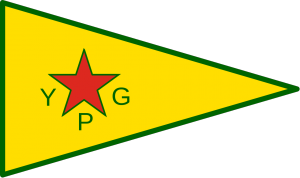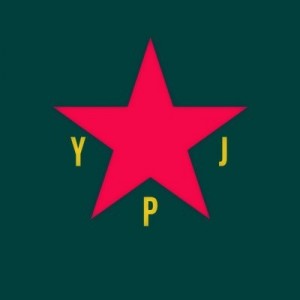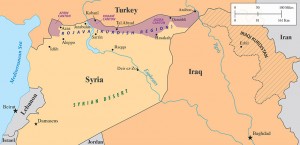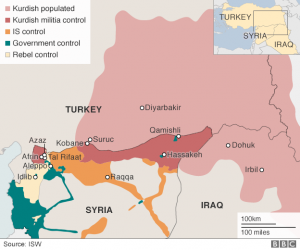Syrian Kurdish Population:
- Majority are Sunni Muslims, though most are more secular than other ethnic groups in the region
- 7-10% of Syria’s population, mostly in northern Syria
- Long been suppressed and denied basic rights by the government, like other Kurds
Militias:
- People’s Protection Unit (YPG)
- Secular, guerilla force
- Most but not all are Kurdish; include European Kurds and some non-Kurds fighting with the YPG
- Estimated 50,000 fighters (June 2015)
Priorities:
- Protecting Kurdish-self-rule and oil from confiscation
- Uniting historically Kurdish areas of Syria into contiguous land mass
- “Democratic self-administration”, not independence
- Defending themselves against Assad (lower priority)
Political Association:
- YPG is the armed wing of the Syrian Kurdish Democratic Unity Party (PYD)
- Left-wing democratic socialism
- Closely linked to Turkish PKK (Kurdistan Worker’s Party- militant group considered terrorist organization by Turkey and West)
Support:
- US started airdropping supplies and ammunition to the YPG in 2014 and US air support helped YPG defeat ISIS at Kobani
- Friendly with Russia, who says the Kurds must be allowed at peace talks
- Part of the Syrian Democratic Force: a coalition of Arab and Kurdish fighters in Northeast Syria
- Has received military assistance from Iraqi Kurdish fighters
- Joined forces with Free Syrian Army fighting ISIS
Weaknesses and Criticisms:
- Ambiguous towards Assad
- War weariness and anxiety over long periods of military service
- Prosecuting Kurdish opposition groups critical of the PYD
- Accusations of war crimes by Amnesty International
Who are the Kurds?
The Kurds are the fourth largest ethnic group in the Middle East and are united through a shared ethnicity, culture, and language. The majority are Sunni Muslims, though they tend to be more secular than other ethnic groups in the region. The Kurds were originally mountain people, but there are few remaining signs of this today. They are the largest ethnic group in the world without a state of their own, and inhabit areas in Turkey, Syria, Iraq, Iran, and Armenia. Recently, Kurdish leaders have made an effort to revive the Kurdish cultural heritage.
The Syrian Kurds and Assad
Many Syrian Kurds protested against the Assad regime during the Arab Spring in 2011 due to repression they had faced for decades by the regime. However, Assad was less harsh on them than on other protesters throughout Syria. He gave citizenship to 300,000 stateless Kurds and withdrew most of his troops from predominantly Kurdish areas of northern Syria in 2012. Because of this, the Syrian Kurds view Assad as less threatening than ISIS and Turkey, which has led to Turkey accusing of the YPG of cooperating with the Assad regime. Any remaining ties between the Syrian Kurds and the Assad regime are rooted in the 1980s and 1990s when the Hafez al-Assad (father of Bashar al-Assad) backed the Kurdistan Workers’ Party (PKK) in Turkey, with which the YPG is aligned. This was done to spite the Turkish government, with whom Syria had a tense relationship at the time. However, the Syrian Kurds still faced a great deal of repression from the Syrian government.
For more information:
Kurds in Syria, World Directory of Minorities: http://www.justice.gov/sites/default/files/eoir/legacy/2014/10/14/Kurds.pdf
Alliance for Kurdish Rights: http://kurdishrights.org/
All Female Kurdish Unit Takes on ISIS, CNN: http://www.cnn.com/videos/world/2015/12/02/all-female-kurdish-unit-takes-on-isis-pkg-wedeman-cnn-today.cnn
Who are the Kurds? BBC: http://www.bbc.com/news/world-middle-east-29702440
Turkey v Islamic State v the Kurds: What’s going on? BBC: http://www.bbc.com/news/world-middle-east-33690060
A Guide to the Kurds in Iraq and Syria, Middle East Eye: http://www.middleeasteye.net/news/kurds-2135687288
YPG: People’s Protection Units, The Kurdish Project: http://thekurdishproject.org/history-and-culture/kurdish-nationalism/peoples-protection-units-ypg/
We Had Nowhere Else to Go, Amnesty International Report: http://www.al-monitor.com/pulse/files/live//sites/almonitor/files/documents/2015/AI.WeHadNowhereElseToGo.PDF
Helpful Images and Maps
The flag of the Women’s Protection Units (YPJ), which is the all women battalion of the YPG
This info graphic highlights the relationships between the Kurds in Turkey, Syria, and Iraq, and each of their relationships with Turkey.
In the map above, the purple areas show Syrian Kurdistan, known as Rojava. Rojava is made up of three cantons: Afrin, Kobani, and Jazira. Currently, Rojava has a system of “democratic self-administration” within Syria.
The map above compares the areas controlled by the YPG to the areas held by ISIS. The YPG has been one of the most effective forces in the fight against ISIS in Syria.




